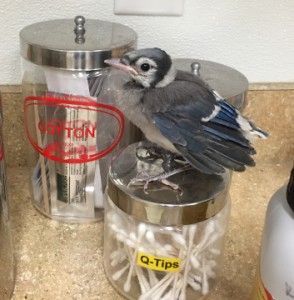Blue Jays and the Physics of “Blue”
Blue Jays are members of the intelligent Corvid family, along with all other species of jays, magpies, crows, and ravens (and even Clark’s Nutcracker). The scientific name of this bird is well chosen: Cyanocitta cristata, from Greek (blue, cyano; chattering bird, kitta) and Latin (with a crest, cristatus). Older range maps show that Blue Jays weren’t found in Colorado until recent years. Their steady march from the east was probably aided by increasingly common bird feeders stretching across the plains, luring these jaunty jewels into our state. Blue Jays are familiar faces at Greenwood; in 2014, we took in 27 nestlings or fledglings and 6 sub-adults or adults.
The most frequent vocalization of the Blue Jay is the “jay! jay!” call that has spawned its common name. In the spring, you might be lucky enough to hear the lovely, almost whispered “qweedle, qweedle” song. (You can hear snippets of both of these here. Scroll down a bit to the “typical voice” section.) But as with most corvids, Blue Jays have huge repertoires of songs, whistles, growls, chatters, and shrieks. They’re also very talented mimics, especially of hawk calls. (If you think you hear a shorter, fainter version of a Red-tailed Hawk’s descending “keeeeeeeeeeeeeeeeeeeer” call, look around to see if any Blue Jays are lurking in the area.) They are omnivores, eating fruit, seeds, small vertebrates (mice, small nestlings)—and they have a special fondness for the nuts of hardwood trees such as oaks or beeches. Jays easily crack these hard nuts, holding them in one foot and hammering them with their strong beaks. (Their beaks even have a special structure to reduce the impact on their brains from this powerful slamming.) They also hide or “cache” food when it’s plentiful, typically under leaves or in the dirt. (Once I offered a young jay at Greenwood a mealworm before I realized it was full. It took the mealworm nicely but started to stuff it between the bars of the cage for later snacking. Okay, we’re done feeding for now!) Although they recover much of what they cache, they are also responsible for helping to “reforest” areas with the sprouts of the seeds they leave behind.
Male and female Blue Jays are pretty much indistinguishable, sporting the same bright, beautiful coloring. Blue Jays establish pair bonds that last for life. Babies fledge 17 – 21 days after hatching, but both parents feed the kids for up to 3 weeks after leaving the nest. Family groups stay together another 2 months, long after the young can feed and fend for themselves.
Like all corvids, Blue Jays are smart and learn very quickly—sometimes learning things we don’t want them to learn. So at Greenwood, we have to be especially vigilant that young Blue Jays don’t form any kind of attachment to their human caregivers. For example, when they “graduate” to an outside aviary, some may still approach a person doing a headcount and refreshing food in the aviary. But we have to be careful to not interact with them or encourage them to engage with a human. According to Colorado Parks and Wildlife regulations, a habituated bird—e.g., one that approaches humans with no sign of fear—cannot be released back into the wild.
Finally, when is blue not really blue? When it’s a feather! In most feathers, colors such as red, yellow, and black result from pigments—the same things that give crayons or paints their various hues. But blue feathers have absolutely no blue pigment. Instead, the structure of any blue feather creates a complex optical illusion, so that light is simply reflected to our eyes as blue. If you crushed a Blue Jay feather, you’d see that its pigments are really just a brownish-gray. Considering the many shades of blue in the avian world—Indigo Buntings, Mountain Bluebirds, Blue Grosbeaks, Steller’s Jays, to name just a few—yet another amazing aspect of feathers comes to “light.”


